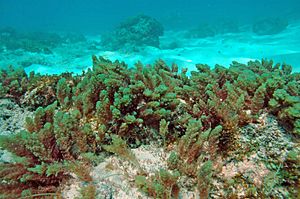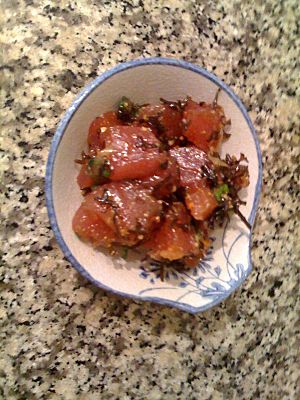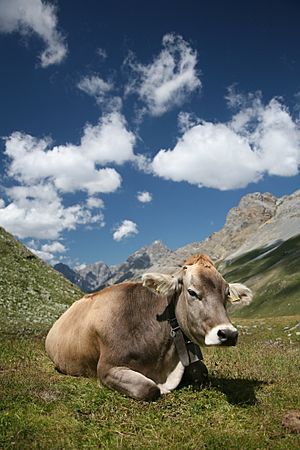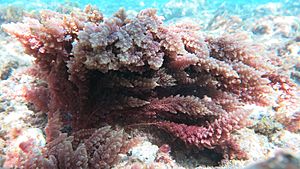Limu Kohu facts for kids
Quick facts for kids Limu Kohu |
|
|---|---|
 |
|
| Asparagopsis taxiformis in Mayotte. | |
| Scientific classification | |
| Synonyms | |
|
Asparagopsis sanfordiana |
Asparagopsis taxiformis, also known as red sea plume or limu kohu, is a type of red algae. You can find it in warm, tropical waters all over the world. It used to be called A. sanfordiana.
Life cycle
Like many red algae, A. taxiformis has a special way of growing called a haplodiplophasic life cycle. This means it has two different stages that look very different from each other. The first stage was even thought to be a completely separate species at one point!
Culinary uses

Asparagopsis is a very popular type of limu (seaweed) used in Hawaiian cooking. It's mostly used as a seasoning. In the Hawaiian language, it's called Limu kohu, which means "pleasing seaweed."
Limu kohu has a slightly bitter taste, a bit like iodine. It's a traditional ingredient in a Hawaiian dish called poke. This seaweed contains natural chemicals, including a lot of bromoform, which is a compound with bromine.
Reducing methane from cattle
In 2014, scientists found something amazing! Researchers at CSIRO and James Cook University discovered that if you feed cows a small amount of red seaweed, it can greatly reduce the amount of methane they burp out. Methane is a powerful greenhouse gas that contributes to climate change.
They tested 20 different types of seaweed. A. taxiformis was the best, reducing methane by almost 99 percent! This discovery made many people interested in using this seaweed to help the environment. Other studies found that certain parts of A. taxiformis were very good at cutting down methane production.
Right now, there isn't enough of this seaweed growing in the wild to feed all the cows. So, scientists and companies are working on ways to farm A. taxiformis on a large scale. Projects like Greener Grazing are trying to figure out how to grow it in the ocean.

Some companies, like Volta Greentech and Symbrosia, are also working on growing A. taxiformis. Symbrosia is even looking into growing it on land, along with whiteleg shrimp. The goal is to grow enough seaweed to make it affordable for farmers around the world.
In 2020, a project called FutureFeed won a $1 million prize for their Asparagopsis product. This product helps reduce methane emissions from farm animals.
Images for kids
-
Ahi limu poke.
-
Cows burp tons of the greenhouse gas methane that comes from their foregut fermentation. However, if only a small percentage of their diet is A. taxiformis, this is greatly reduced.
See also
 In Spanish: Asparagopsis taxiformis para niños
In Spanish: Asparagopsis taxiformis para niños




